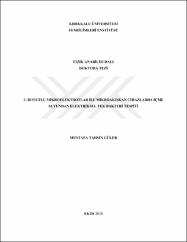| dc.contributor.advisor | Ağan, Sedat | |
| dc.contributor.advisor | Elbüken, Çağlar | |
| dc.contributor.author | Güler, Mustafa Tahsin | |
| dc.date.accessioned | 2021-01-16T19:08:31Z | |
| dc.date.available | 2021-01-16T19:08:31Z | |
| dc.date.issued | 2015 | |
| dc.identifier.uri | | |
| dc.identifier.uri | https://hdl.handle.net/20.500.12587/16636 | |
| dc.description | YÖK Tez ID: 430043 | en_US |
| dc.description.abstract | Suda bulunan patojenler her gün binlerce kişinin ölümüne sebep olmaktadır. Dolayısıyla bakterilerin hızlı ve düşük maliyetli tespiti zaruridir. Bu çalışmada çeşme suyundan tek bir bakterinin elektriksel olarak tespiti gerçekleştirilmiştir. Bakteriler mikron boyutunda olduğundan dolayı empedimetrik tespiti çok zordur. Empedimetrik sitometreler optik sitometreler kadar gelişmiş değildir ancak maliyet ve basitlik açısından çok büyük bir potansiyele sahiptir. Empedimetrik tespitte hassasiyetin arttırılması için mikro üretim teknikleri uygulanmıştır. Mikro elektrotlar liftoff yöntemiyle, mikro kanallar da soft litografi yöntemiyle temiz oda içerisinde üretilmiştir. Mikro kanallar mikro elektrotlarla plazma yardımıyla birleştirilerek mikro akışkan çip oluşturulmuştur. Parçacıklar mikro kanaldan geçirilerek ve LCR metre ile tespiti yapılmıştır. İşin fiziğini incelemek ve hassasiyetini arttırmak için Comsol simülasyonları yapılmıştır. Çok ince hücre zarına sahip olan bakterileri incelemeye izin veren yeni bir elektriksel eşdeğer devre yaklaşımı geliştirilmiş ve uygulanmıştır. Bunun dışında yeni bir mikro akışkan çip üretme yöntemi geliştirilmiştir. Bu çiplerin üretimi 3 cm uzunluğunda çapı 25 µm olan atın tel lama yapıştırılıp ve üzerine de mikro kanal takılarak gerçekleştirilmiştir. Ardından kral suyu karışımı kanaldan geçirilerek altın tel aşındırılma yöntemiyle ikiye bölünmüş ve iii 3D elektrotlar oluşturulmuştur. Bu yeni tip elektrotların alışıldık yöntemlerle üretilen elektrolardan daha hassas olduğu deneysel olarak da kanıtlanmıştır. Son olarak 3D elektrotlar ile çeşme suyundan tek bakterinin tespiti gerçekleştirilmiştir. | en_US |
| dc.description.abstract | Water borne pathogens cause thousands of deaths every day. Therefore rapid and low cost detection of bacteria is a mandatory task. In this study, electrical detection of single bacterium from tap water was done. Detection of bacteria, as micron size organisms, is a big challenge for impedimetric detection. Impedimetric cytometers are not as advanced as optical cytometers despite their great potential in terms of simplicity and cost. Microfabrication techniques were applied to increase sensitivity of impedimetric detection. Microelectrodes were fabricated with lift-off method and microchannels were fabricated with soft lithography in cleanroom. Microelectrodes and microchannels were bonded with plasma treatment forming the microfluidics chip. Particles were sent through the microchannel and electrical detection was done with LCR meter. To investigate the physics and increase the sensitivity Comsol simulations were realized. A new electrical equivalent circuit approach was developed and applied which enabled the investigation of bacteria having very thin cell membrane. New fabrication method of microfluidic chip was also developed. For the fabrication, 25 µm diameter, 3 cm long gold micro wire was attached on v glass substrate and micro channel was bonded on top. Then, etchant solution was sent through the channel and divided the micro wire forming the 3D electrodes. Those new electrodes were also proven to be superior in sensitivity. Finally, a single bacterium was detected using 3D electrodes from tap water directly without any labeling. | en_US |
| dc.language.iso | tur | en_US |
| dc.publisher | Kırıkkale Üniversitesi | en_US |
| dc.rights | info:eu-repo/semantics/openAccess | en_US |
| dc.subject | Biyofizik | en_US |
| dc.subject | Biophysics ; Biyoteknoloji | en_US |
| dc.subject | Biotechnology ; Fizik ve Fizik Mühendisliği | en_US |
| dc.subject | | en_US |
| dc.subject | | en_US |
| dc.subject | | en_US |
| dc.subject | | en_US |
| dc.subject | | en_US |
| dc.subject | | en_US |
| dc.subject | | en_US |
| dc.title | 3- boyutlu mikroelektrotlar ile mikroakışkan cihazlarda içme suyundan elektriksel tek bakteri tespiti | en_US |
| dc.title.alternative | Electrical detection of a single bacterium in tap water using a microfluidic device with novel 3-dimensional microelectrodes | en_US |
| dc.type | doctoralThesis | en_US |
| dc.contributor.department | KKÜ, Fen Bilimleri Enstitüsü, Fizik Anabilim Dalı | en_US |
| dc.identifier.startpage | 1 | en_US |
| dc.identifier.endpage | 128 | en_US |
| dc.relation.publicationcategory | Tez | en_US |
















